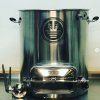I just had the internal struggle you’re dealing with now. I was tired of stuck sparges due to the way my false bottom sat in the bottom of my 10 gallon cooler mash tun. However, I felt if I was buying new I should go with a little more volume (especially after my wife got me a 30 gallon brew pot so I could do bigger batches of the stuff that seems to run out quick- she feeds the addiction) but I didn’t want to limit myself to only larger (>5 gal) batches. I was stuck between the two sizes of SSbrewtech MLTs, or making my own MLT with a 15 gallon kettle.
Before deciding I did a bunch of research on here and on other places. A lot what I was looking at was the effects of a short grain bed in a wide MLT (as in a low OG 5 gallon batch in the 20 gallon MLT). I finally decided most of those effects, for various reasons, would likely be small due to the design of the MLT and the rest of my HERMS setup. But I figured I’d give you some of my thought process and why in the end I decided to get the bigger MLT. Granted, I’ve only used the new MLT one time so far, for a 10 gallon batch of ~6% stout, so take my discussion for what it’s worth.
1. As pointed out already, the biggest downside will be the heat loss due to additional head space. For me, I have a HERMS system, so that helps a lot. And your RIMS system will be even better I would imagine. If you find it working too hard to maintain temps, or there is a lot of inconsistency, you could always DIY insulate the MLT or try the “aluminum foil above the grain bed” trick to minimize heat loss (my guess is those steps won’t be necessary with RIMS).
2. Loss of efficiency due to channeling type effect from the short grain bed: not saying there isn’t any effect, but I think it’d be a lot more if I was using a bazooka screen instead of the false bottom. Not something I will ignore going forward, but with the continuous HERMS recirc and doing slow lautering, I think it could be only a small impact. I will definitely watch for this efficiency loss when I do smaller grain bill beers.
3. Similar to #2- Poor rinsing during sparge / poor temperature distribution: I have a recirc manifold that distributes wort back to the MLT pretty evenly, and a sparge arm that I keep the bottom submerged in 1-2” of water on top of the grain bed. Again- Going slow during sparge / lauter will also help keep things distributed evenly.
4. Poor filtering qualities of a short grain bed: I guess this one considers the bed is too short to really act as a filter during runoff. However, I think that discussion was more for a batch/fly sparge system- not considering a full time mash recirc like RIMS or HERMS. Once again, no real experience in that department yet- but my guess is it wouldn’t be much of an issue due to a full time recirc allowing the bed to set throughout the entire mash (not just during a vorlauf at the end).
In the end, I decided to go with the bigger MLT knowing the downside is being forced to do only 10+ gallon batches of some beers. The other possibility if I find it ant working out for smaller 5 gallon beers is I swap out MLTs and use the old reliable orange cooler when needed. My opinion- do it. But then again I am a bad conscience.
[Edited to make it read better, took out a lot of words]





![Craft A Brew - Safale S-04 Dry Yeast - Fermentis - English Ale Dry Yeast - For English and American Ales and Hard Apple Ciders - Ingredients for Home Brewing - Beer Making Supplies - [1 Pack]](https://m.media-amazon.com/images/I/41fVGNh6JfL._SL500_.jpg)





















































